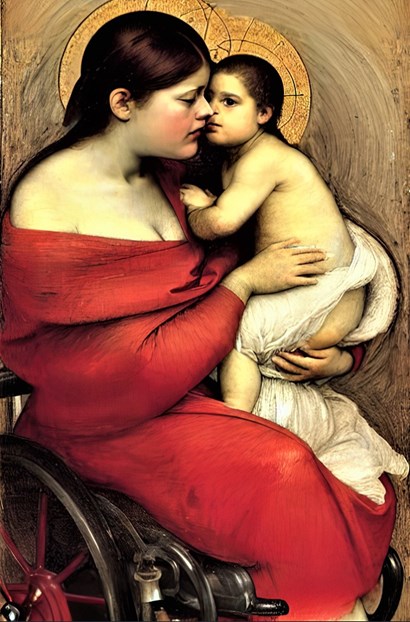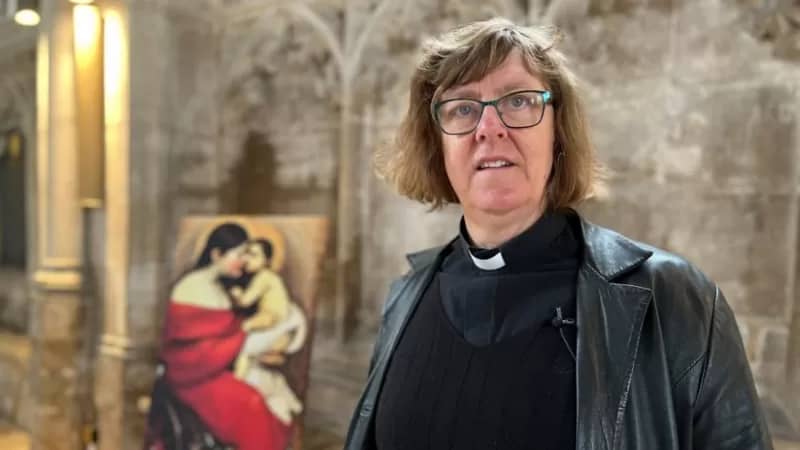By Alexander Ogene
From the United Kingdom, a painting on display at the Petersborough Cathedral art exhibition is silently instigating a new slant and tang to the Disability inclusion struggle.
The art exhibition which started on Tuesday, May 16 runs till Friday 7, July 2023.
This time the church is in the eye of the storm and perceptive minds think it’s a matter of time before the ripple effect shall be felt across continents.
The rallying call: “Give us a handful of dedicated thinkers of the “inclusion persuasion” and we’d prick the conscience of the church – redirecting her to the good old path.
Long overdue, but finally…
Inclusion is coming to church in a thinking that’s both refreshingly and controversially “out of the box – thanks to artist Marc Bratcher’s painting of the Virgin Mary as a person with a disability in a wheelchair.
A first of its kind
Marc’s painting titled: “Disability and the Divine” is believed to be the first public exhibition of its kind.
“As far as I’m aware there has never been a representation or an interpretation of the Virgin Mary as a disabled woman”, so I’m interested in starting a conversation culturally, theologically, historically, and also, what it means for today”, says Marc.
Inspirational Dissatisfaction:
Marc, who has cerebral palsy demonstrates that Disability has been largely absent from art. And fellow PWD Sandie Burns of Disability Petersborough reasons:
“You could say disabled people have been airbrushed out, but they were never put in, in the first place, to be airbrushed out. The fact that Marc has put disability at the center of these pictures is a good talking point”.
And it’s a good thing the deeper essence of the picture is being pretty well understood by both preachers and pew at the Petersborough cathedral.
Authorities at the cathedral said: “We wanted to host the exhibition (Disability and the Divine) to make people with Disabilities less invisible in religious and nonreligious settings.”
Background
Marc, in an official statement intended to provide a background to his work, Disability, and the Divine writes:
“For many years there has been a tradition of representing key figures from Christianity in ways that reflect different cultural perspectives – such as the African Virgin Mary or Asian Jesus… It is in this tradition, and inspired by the new climate of inclusivity and stimulating more engagement within the community that my religious works explore these ideas through the image of the disabled Virgin Mary”.
The artist is however careful to categorically point out that he isn’t saying Mary was disabled. He reminds, “neither is it about political correctness, but rather…offers the chance of a significant part of the Christian community…to see themselves reflected in the Christian story…”
Redirecting the narrative
Bratcher believes that works like this can provide stimulus and focus for better discussions and a broader understanding of the roles of persons with disabilities within the church in ways that better reflect the progressive attitudes of the 21st century.
And he’s not alone in his convictions.
Dr. Rowan Williams, canon at Petersborough Cathedral comments: “I am pleased to be able to offer a space that helps people with Disabilities to see themselves represented in ways that perhaps, they haven’t before. As a person with a disability (mild) myself, it is something that I feel very strongly about and would want to see us actively doing more to encourage”
Meanwhile, Petersborough’s Vice Dean, Tim Alban Jones remarks, “While Marc’s painting shows us a different and surprising view of very familiar subjects, they are profoundly beautiful and moving. He continues: “I hope they will start a conversation around the invisibility of people with Disabilities in religious settings and challenge us to change for the better”.
More substantially
But the substance of Marc’s work goes beyond merely bringing disability-centric images into the church.
More sublimely, it speaks to putting salient disability concerns on the front burner of church theology and discussions.
Through his work, this disabled artist opens slumbering consciousness to more radical and pungent ways by which this may be done.
Indeed, the global Christian community needs to wake up to the deeper undertones of Bratcher’s inspired art.
Thinking out of the box
For the thinking writer, it’s time to put more energy into exploring the nexus between disability and matters of faith.
For the theologian/preacher, it’s time for a deeper examination of what the sacred writs say about Disability.
For the faith healer, it’s time to learn to discern the thin line between faith and reason.
For the pew, it’s time to realign with “be ye doers of the word and not hearers only”.
The ripple continues…
As Marc emphasizes: “Even more important, this project (Disability and the Divine)…pose many profound questions of faith and touch on very important theological issues.
For example, it gets us to think about what perfection is – both of the spirit and the body.
Jonathan Evens, in his review of Disability and the Divine for Church Times, UK, sums it up superbly, this project throws light on the lived experiences of people with disabilities and what unique insights into the subject of faith and spirituality such offers.
But whether or not the church universal is ready to heed the call is another kettle of fish.
And so we have here a litmus test for gauging ableism and non-inclusion within the church.
Acknowledgment
Special thanks to my friend, Peter Torres Fremlin whose impressive compendium of disability news and stories in the Disability Debrief newsletter https://www.disabilitydebrief.org/ keep providing inspiration and opening up new perspectives on the subject of disability blogging.


